How plants conquered the land (I) (II)
Fossils tell the story
About fourhundred and fifty million years ago, at the end of the Ordovician
and in the beginning of the Silurian, the land was desolate and empty. Barren,
hardly wethered rockgrounds, empty sand-, gravel- and clayplains, no green.
Maybe some lichens. And at wet spots some algae with a couple of spider-like
little creatures creeping around. In the neighbourhood of the mouth of rivers,
where the water regularly flooded the land, it was probably green with algae.
At such places, e.g. in Australia, traces of big seascorpions have been found.
There was not much happening on the land. Life enacted itself nearly completely
in the water.
The oldest indications for the existence of real land plants have been
found in cores from boreholes in Oman. They contained fours of mutually connected
spores (tetrads) enveloped by remains of the spore sac in which they
had been formed. Research on the spore walls point to a relationship with
the liverworts. The fossils have been found in the Middle Ordovician and
are about 475 million years old.
Cooksonia
The first fossils of macroscopic land plants have been found in the
Middle Silurian of Ireland.
They are about 425 million years old. They consist of small bifurcations
some centimeters in size. Only in the very last part of the Silurian fossils
of land-plants become
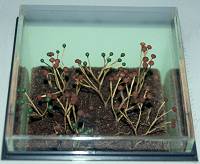 more common and also more
complete. The best known plant from that time is called Cooksonia.
It is named after Isabel Cookson, who occupied herself with intensive collecting
and describing plantfossils. more common and also more
complete. The best known plant from that time is called Cooksonia.
It is named after Isabel Cookson, who occupied herself with intensive collecting
and describing plantfossils.
The little plant looked very simple: a stem which bifurcated a couple of
times topped with small spheres in which the spores were formed. Thus sporangia.
No leaves, no flowers, no seeds. And roots? Probably horizontal growing stems,
connected with the soil by root hairs, took the function of roots. But this
is not sure for fossils proving this have not been found yet.
During many millions of years it was mainly this kind of plants that grew
on humid places on the land. (Click
here for a more extensive
description of Cooksonia)
The evolution from algae to land plants must have
been a lengthy process.
Many conditions had to be fulfilled before plants were able to maintain
themselves on the land. There is at first the everlasting danger of desiccation.
The remedy which developed is a thin waxy layer at the surface of the plant:
the cuticle. Generally algae don't have a cuticle, nearly all land plants
do.
But a land plant also has to breath and it needs the possibility to assimilate
carbondioxide from the air to generate its nutriments. Thus the isolation
by the cuticle can not be absolute. That's why the stomata have evolved,
which can be opened and closed if necessary.
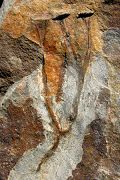
 Another problem for land plants is that they miss the upward force of the
water. To be able to keep upright supporting tissue is needed. Already in
Cooksonia xylem vessels have been recorded. These
are vessels with annular or spiral shaped thickenings at the walls, which
give them solidity. Through these vessels water is transported from the soil
to the plant cells.
Another problem for land plants is that they miss the upward force of the
water. To be able to keep upright supporting tissue is needed. Already in
Cooksonia xylem vessels have been recorded. These
are vessels with annular or spiral shaped thickenings at the walls, which
give them solidity. Through these vessels water is transported from the soil
to the plant cells.
Another important adaptation to landlife is the very tough wall that evolved
around the spores. This provided the spores with an excellent protection
against desiccation, fungi, and so on. In fact they became nearly invulnerable,
for they have been fossilised very often.
Species of Cooksonia are found at several places on earth, e.g.
in Wales, Scotland, England, Czechia and Canada. The finding of a fairly
complete plant is a rare occurrence. I was already very glad with the bifurcated
little stem with two sporangia between Cooksonia-chaff on the photo.
Cooksonia has become extinct in the Early Devonian.
Baragwanathia
A plant, almost as old as Cooksonia, is
Baragwanathia
longifolia. There has been a lot of discussion about the age of this
clubmoss-like plant, but now it is believed to be Early Ludlow
(from 420 million years on). The repeatedly branched stems have a length
of 10 to 20 cm and they are covered with long, needle-like leaves. Sometimes
sporangia are present and transverse sections of the stems show a vascular
strand like in other higher plants. The plant has a remarkably high degree
of development in relation to its age. Baragwanathia longifolia
has only been found in Australia.
Enigmatic plants
At the time of the first Cooksonias a completely different group
of plants has evolved, which tried to colonize the land. These plants are
still enigmatic for scientists. Research for the real nature and the ecology
of these plants is still in full progress. We shall mention three of them
(there are more): Nematothallus, Parka and Pachytheca.
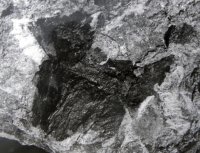  Fossils
of Nematothallus look like black patches
measuring 0,5 to 6 cm. They are irregular in shape and sometimes there is
still a thick cuticle on the plant. It is possible to make a microscopic
preparation of a piece of cuticle and in some cases it turns out to have
a cell structure. As this has not developed in the way of cell division in
higher plants it is called pseudo cell structure. Under the cuticle is a
little mat consisting of very thin threads or tubes. The diameter of such
a tube varies from 3 µms to 40 µms (1 µm = one thousandst
of a millimeter). Spores have also been found in the mats. Apparently
Nematothallus did consist of a thallus of fine threads (Gr. nemato
= thread) covered by a thick cuticle, sometimes with a pseudo cell structure.
Plants like these do not exist any more, however there are recent lichens
resembling Nematothallus in several aspects. Fossils
of Nematothallus look like black patches
measuring 0,5 to 6 cm. They are irregular in shape and sometimes there is
still a thick cuticle on the plant. It is possible to make a microscopic
preparation of a piece of cuticle and in some cases it turns out to have
a cell structure. As this has not developed in the way of cell division in
higher plants it is called pseudo cell structure. Under the cuticle is a
little mat consisting of very thin threads or tubes. The diameter of such
a tube varies from 3 µms to 40 µms (1 µm = one thousandst
of a millimeter). Spores have also been found in the mats. Apparently
Nematothallus did consist of a thallus of fine threads (Gr. nemato
= thread) covered by a thick cuticle, sometimes with a pseudo cell structure.
Plants like these do not exist any more, however there are recent lichens
resembling Nematothallus in several aspects.
Fossils of Nematothallus have been found in formations from the Middle
Silurian up to and including the Early Devonian. In Great-Britain they are
found in several places.
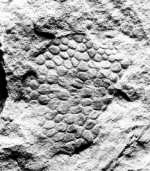  A second enigmatic
plant is Parka. This is a flat, circular to irregular
patch covered by discs about 2 mm wide. These are sporangia each containing
some 35,000 spores. The diameter of this plant varies from 0,5 cm to 7 cm.
Where the sporangia have disappeared from the fossils, and this is often
the case, a kind of reticulum remains. For a long time Parka has
been supposed to be a collection of some animal's eggs. Especially in the
region of Forfar, north of Dundee in Scotland, Parka is very common.
Click here for a more
extensive description of Parka. A second enigmatic
plant is Parka. This is a flat, circular to irregular
patch covered by discs about 2 mm wide. These are sporangia each containing
some 35,000 spores. The diameter of this plant varies from 0,5 cm to 7 cm.
Where the sporangia have disappeared from the fossils, and this is often
the case, a kind of reticulum remains. For a long time Parka has
been supposed to be a collection of some animal's eggs. Especially in the
region of Forfar, north of Dundee in Scotland, Parka is very common.
Click here for a more
extensive description of Parka.
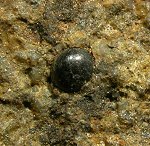 The third still
unelucidated plant is Pachytheca. This fossil
resembles a gleaming little globe with a diameter between 1 and 7 mms. In
transverse the sphere has an outer layer with radial tubes and a nucleus
in which the tubes are going in all directions. For a long time
Pachytheca was thought to be part of a bigger plant, but nowadays
it is firmly believed to be a complete organism. The fossils have been found
in e.g. Belgium and Great-Britain. This plant too became extinct in the Early
Devonian. Click
here for a more extensive
description of Pachytheca. The third still
unelucidated plant is Pachytheca. This fossil
resembles a gleaming little globe with a diameter between 1 and 7 mms. In
transverse the sphere has an outer layer with radial tubes and a nucleus
in which the tubes are going in all directions. For a long time
Pachytheca was thought to be part of a bigger plant, but nowadays
it is firmly believed to be a complete organism. The fossils have been found
in e.g. Belgium and Great-Britain. This plant too became extinct in the Early
Devonian. Click
here for a more extensive
description of Pachytheca.
Probably these and similar alga-like plants can be considered as an
evolutionary experiment to colonize the land. It seems having been a dead
end. It is not unlikely that these plants have lost the increasing competition
with the succesful higher plants.
At the photo below of a slab from Forfar in Scotland
four of these very old plants are represented: Nematothallus (1),
Parka (2), Pachytheca (3) and Zosterophyllum (4).
Use the cursor as a magnifying glass. The enlargement can be changed
by turning the mouse wheel.
Width of the photo 17 cm. Lower Devonian. Forfar (Scotland).
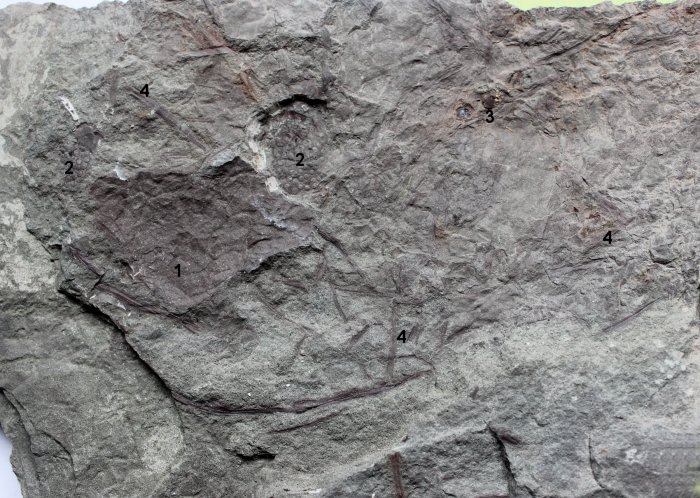
Continuation
Top |